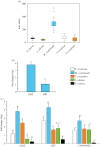Plant defences against ants provide a pathway to social parasitism in butterflies
- PMID: 26156773
- PMCID: PMC4528562
- DOI: 10.1098/rspb.2015.1111
Plant defences against ants provide a pathway to social parasitism in butterflies
Abstract
Understanding the chemical cues and gene expressions that mediate herbivore-host-plant and parasite-host interactions can elucidate the ecological costs and benefits accruing to different partners in tight-knit community modules, and may reveal unexpected complexities. We investigated the exploitation of sequential hosts by the phytophagous-predaceous butterfly Maculinea arion, whose larvae initially feed on Origanum vulgare flowerheads before switching to parasitize Myrmica ant colonies for their main period of growth. Gravid female butterflies were attracted to Origanum plants that emitted high levels of the monoterpenoid volatile carvacrol, a condition that occurred when ants disturbed their roots: we also found that Origanum expressed four genes involved in monoterpene formation when ants were present, accompanied by a significant induction of jasmonates. When exposed to carvacrol, Myrmica workers upregulated five genes whose products bind and detoxify this biocide, and their colonies were more tolerant of it than other common ant genera, consistent with an observed ability to occupy the competitor-free spaces surrounding Origanum. A cost is potential colony destruction by Ma. arion, which in turn may benefit infested Origanum plants by relieving their roots of further damage. Our results suggest a new pathway, whereby social parasites can detect successive resources by employing plant volatiles to simultaneously select their initial plant food and a suitable sequential host.
Keywords: Maculinea; ant; gene expression; host detection; myrmecophily; plant volatiles.
Figures




Similar articles
-
Origanum vulgare terpenoids modulate Myrmica scabrinodis brain biogenic amines and ant behaviour.PLoS One. 2018 Dec 26;13(12):e0209047. doi: 10.1371/journal.pone.0209047. eCollection 2018. PLoS One. 2018. PMID: 30586439 Free PMC article.
-
Acoustical mimicry in a predatory social parasite of ants.J Exp Biol. 2009 Dec;212(Pt 24):4084-90. doi: 10.1242/jeb.032912. J Exp Biol. 2009. PMID: 19946088
-
Host specificity pattern and chemical deception in a social parasite of ants.Sci Rep. 2019 Feb 7;9(1):1619. doi: 10.1038/s41598-018-38172-4. Sci Rep. 2019. PMID: 30733477 Free PMC article.
-
The ecology and evolution of ant association in the Lycaenidae (Lepidoptera).Annu Rev Entomol. 2002;47:733-71. doi: 10.1146/annurev.ento.47.091201.145257. Annu Rev Entomol. 2002. PMID: 11729090 Review.
-
The arms race between heliconiine butterflies and Passiflora plants - new insights on an ancient subject.Biol Rev Camb Philos Soc. 2018 Feb;93(1):555-573. doi: 10.1111/brv.12357. Epub 2017 Sep 13. Biol Rev Camb Philos Soc. 2018. PMID: 28901723 Review.
Cited by
-
Eavesdropping on cooperative communication within an ant-butterfly mutualism.Naturwissenschaften. 2016 Oct;103(9-10):84. doi: 10.1007/s00114-016-1409-5. Epub 2016 Sep 27. Naturwissenschaften. 2016. PMID: 27679457
-
Origanum vulgare terpenoids modulate Myrmica scabrinodis brain biogenic amines and ant behaviour.PLoS One. 2018 Dec 26;13(12):e0209047. doi: 10.1371/journal.pone.0209047. eCollection 2018. PLoS One. 2018. PMID: 30586439 Free PMC article.
-
Methyl Jasmonate Induces Genes Involved in Linalool Accumulation and Increases the Content of Phenolics in Two Iranian Coriander (Coriandrum sativum L.) Ecotypes.Genes (Basel). 2022 Sep 24;13(10):1717. doi: 10.3390/genes13101717. Genes (Basel). 2022. PMID: 36292602 Free PMC article.
-
Influence of Digestion Procedure and Residual Carbon on Manganese, Copper, and Zinc Determination in Herbal Matrices by Atomic Absorption Spectrometry.J Anal Methods Chem. 2017;2017:6947376. doi: 10.1155/2017/6947376. Epub 2017 Oct 19. J Anal Methods Chem. 2017. PMID: 29123940 Free PMC article.
-
Origanum vulgare Terpenoids Induce Oxidative Stress and Reduce the Feeding Activity of Spodoptera littoralis.Int J Mol Sci. 2018 Sep 18;19(9):2805. doi: 10.3390/ijms19092805. Int J Mol Sci. 2018. PMID: 30231481 Free PMC article.
References
-
- Thompson JN, Pellmyr O. 1991. Evolution of oviposition behaviour and host preference in Lepidoptera. Annu. Rev. Entomol. 36, 65–89. (10.1146/annurev.en.36.010191.000433) - DOI
-
- Thomas JA, Simcox DJ, Hovestadt T. 2011. Evidence based conservation of butterflies. J. Insect Conserv. 15, 241–258. (10.1007/s10841-010-9341-z) - DOI
-
- Renwick JAA, Chew FS. 1994. Oviposition behavior in Lepidoptera. Annu. Rev. Entomol. 39, 377–400. (10.1146/annurev.en.39.010194.002113) - DOI
-
- Elmes GW. 1996. Biological diversity of ants and their role in ecosystem function. In Biodiversity research and its perspectives in East Asia (eds Lee BH, Kim TH, Sun BY.), pp. 33–48. Jeonju, Korea: Chonbuk National University.
-
- Thomas JA, Schönrogge K, Elmes GW. 2005. Specializations and host associations of social parasites of ants. In Insect evolutionary ecology (eds Fellowes ME, Holloway GJ, Rolff J.), pp. 479–518. Wallingford, UK: CABI.
Publication types
MeSH terms
Substances
LinkOut - more resources
Full Text Sources
Other Literature Sources

